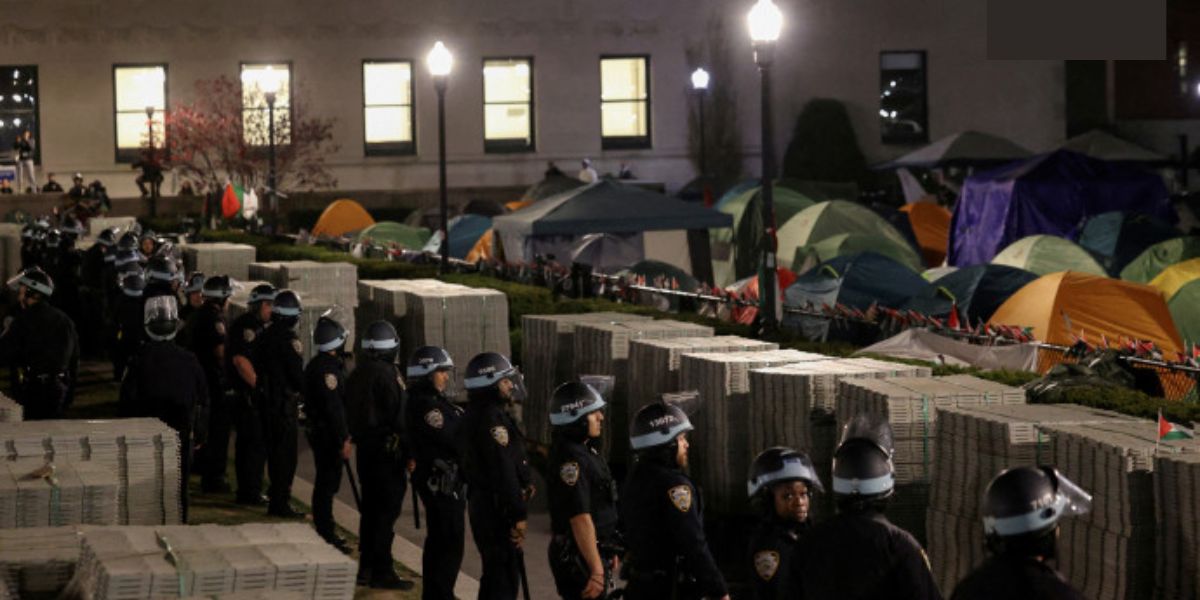NYC Claims ‘No Injuries’ In Columbia Arrests Contradicted By Students’ Medical Records
NEW YORK – New York Mayor Eric Adams and top police officials stated on multiple occasions that there were “no injuries,” “no violent clashes,” and no force was utilized following the arrests of pro-Palestine student demonstrators who had taken over a Columbia University building last month.
But according to medical documents, protestor-shared photos, and interviews, at least nine of the 46 demonstrators who were detained inside the closed Hamilton Hall on April 30 suffered injuries more serious than minor cuts and bruises.
Ankle sprains, wounds, shattered eye sockets, and damage to the hands and wrists from tight plastic flexicuffs were among the recorded injuries.
Third-degree trespassing is a misdemeanor that was brought against each of the 46 demonstrators who were taken into custody within Hamilton.
After calling in police hours into the occupation at the center of a student protest movement that has expanded to schools throughout the globe, Columbia President Minouche Shafik made the highly contested decision to call in the arrests. Pro-Palestinian and anti-Israel demonstration camps have been suppressed by calling in the police, according to other university administrators across the nation.

Columbia, the mayor’s office, and the New York police department were all informed by Reuters of the injuries sustained by the demonstrators. None denied the wounds. The police and mayor’s offices said that the cops behaved professionally.
Time-stamped medical records indicate that that evening, police transported at least three wounded demonstrators who had been detained within Hamilton to hospitals.
SEE MORE – Check Details! 50-Year-Old Woman Found With Neck Injuries In Brooklyn, Police Launch Investigation
Moments after being released from detention on May 2, volunteer medics who support those who are arrested by the police gathered with other protestors to chronicle their injuries. These protestors are demanding that Columbia divest from firms that manufacture weapons and other businesses that bolster the Israeli government. At clinics, some then went to seek medical care.
“I was forcefully thrown to the floor and, as I looked around to see if any of my teammates required help, an officer struck me in the eye. I fell straight to the ground, and my ears began to ring and buzz intensely,” described 25-year-old graduate student Christopher Holmes of Union Theological Seminary, a Columbia affiliate institution.
Holmes reported that shortly after, an officer struck the left side of his forehead with Hamilton Hall’s floor.
Iam Holmes was escorted to a Manhattan hospital by a friend, his eye remained inflamed days after his release. Doctors found that he had a shattered eye socket and a concussion, according to hospital documents.
WE DO NOT HOLD ARMS!
Mayoral spokesman Kayla Mamelak would not explain when the mayor found out that demonstrators had suffered injuries. During a press conference with police chiefs on May 1, Adams stated that the arrests were “organized, calm and that there were no injuries.”
Encountering hundreds of armed officers in riot gear, Mamelak wrote in an email that the arrests were “a complicated operation” that was conducted “with professionalism and respect.”
An unnamed police spokeswoman acknowledged that the demonstrators had been injured, but said in an email that the cops had acted “swiftly, professionally, and effectively.”
SEE MORE – 19-Year-Old Faces Murder Charges After Teen Fatally Shot In SoHo And Caught Or Not?
The raw footage from the cops’ body cams, the use-of-force reports, and the injury reports from the arrests were all declined by the two spokespeople. Police forcibly removed journalists from campus that evening and ordered students outside Hamilton into dorms.
Ben Chang, a representative for Columbia, promised to reply to inquiries by May 10 but never did. Following the release of this report, he sent an email expressing Columbia’s gratitude to the police department “for their support of our community and neighborhood throughout this challenging time.”
The university, he said, “would take seriously any complaints of inappropriate behavior and would investigate them.”
Several demonstrators claimed they sat on the floor in Hamilton’s lobby with their hands raised while police used electric saws to cut through barriers made of bulky furniture and bike chains. The police then barged through the doors after throwing in a flash-bang grenade that let out jarring loud bangs and flashes of light.
Research assistant Gabriel Yancy, 24, who was sacked from his position at a neuroscience lab at Columbia, claimed to have seen police kick a protester in the abdomen, walk on three protestors, and toss some to the ground.
Student Aidan Parisi, 27, who studies social work at Columbia, described how police were “stepping on top of people, throwing people,” and how some demonstrators cried, “We are unarmed!”
A few pupils reported that the cops made a strong bend over them. A ban on knee restraints that compress the diaphragm was enacted by New York City in 2020.
The New York State Attorney General and the New York Police Department came to a reform agreement last year to stop the department’s “pattern of excessive force” against protestors. Gideon Oliver, a civil rights attorney, is currently representing several of the student arrests.
“Now is the time for the city and for the police department to deescalate and to stop engaging in tactics on the streets that appear designed to chill protests,” Oliver claimed.











